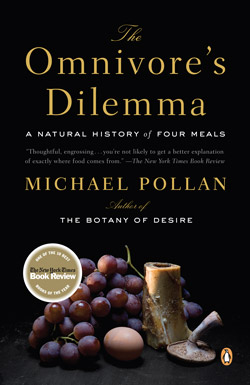 A miraculous flashback
A miraculous flashback
Published by: Penguin
ISBN-13: 978-0143038580
Pages: 450
Price: INR 1055
Far removed from our hunter-gatherer life where daily survival once depended on avoiding predators and finding enough to eat, humans today sit at the top of the food chain as the ultimate omnivore.
With the ability to eat whatever we want, figuring out what not to eat is not easy. Many foods have the potential to make us sick or, in extreme cases, even kill us.
This in short is the Omnivore’s Dilemma.
The book is laid-out in three sections: Industrial, Pastoral and Personal. Well-written and engaging, Michael Pollan presents his research with immense clarity.
In the first section, we learn how industrialisation has systematically removed us from our food source. Focussing on the ubiquitous corn, we learn how it has evolved over time: genetically modified to pervade the food market from plain old corn-on-the-cob to high fructose corn syrup, which seems a staple in many processed foods. As corn provides a large return on investment and is plentiful, there is no incentive to re-evaluate its highly industrialised production and consumption.
The second section talks about the merits of organic foods, be it meat or vegetables. Organic stood for everything industrial was not. In this age where ‘organic’ has become a polarising word, we learn the difference between industrial organic and sustainable organic. Considering the high cost of fuel to transport food from growers to consumers, organic farming is only meaningful when it supports the local community, which means we need a lot more food producers than we have now to serve this cause. This locavorism [eating only locally produced food] has been under debate due to the disruption it can cause to the local ecosystems.
Considering the increase in meat consumption, it is clear that once ‘meat farms’ came into existence, there was no going back. No longer do we have to hunt for meat. We simply cultivate animals like crops and slaughter them in the name of harvesting. “The industrial animal factory offers a nightmarish glimpse of what capitalism is capable of, in the absence of any moral or regulatory constraint.”
In the third section, the author attempts to hunt, forage and prepare a meal on his own, knowing exactly where each of the ingredients came from. The merits of vegetarianism are explored but, eventually, we are made to realise that ‘we eat by the grace of nature, not by industry.’
The issues are far too complex and the author does not attempt to give a definite solution. Instead, he leads us to a logical and eye-opening conclusion—that all of us need to take an active role in our own food systems. We must ask ourselves, What exactly are we eating? Where is our food coming from? Why should we care?
With abundant supply of sustenance that borders on decadent indulgence, it is easy to lose sight of the fact that our food choices affect not just us but the world around us, even though that may not be obvious right away. We are connected to the soil, plants, animals and everything that surrounds us, the book reminds the reader.
Laced with mild humour, the profoundly informative book helps us understand that we are what we eat.
This was first published in the June 2014 issue of Complete Wellbeing.

